NCPTT’s Archeology & Collections program seeks to enhance the
preservation of archeological sites, landscapes, materials, and collections
through research, grants, and partnerships.
NCPTT awarded the Forbes Award by Association for Gravestone
Studies
The Monument Builders of North America nom inated N C P T T ’s
Cemetery Initiative for the Association of Gravestone Studies’s Harriette
Merrifield Forbes Award. NCPTT received the 2006 award at the AGS annual meeting
in Doylestown, PA. The AGS only awards one Forbes Award per year to recognize
“outstanding contributions in such areas as scholarship, publications,
conservation, education, and com m unity service.” Additionally, Jason Church
presented on the topic of the history and care of cast iron grave markers to a
large and appreciative audience.
NCPTT and NSU embark on a New Joint Laser Research Facility
A new venture was established with NSU to house the Laser
Research Facility available for use by NSU and NCPTT researchers . At the heart
of this new facility is a Nd-YAG (Neodynium-Yttrium Aluminum Garnet) laser
formerly used by the Los Angeles County Museum of Art for research into laser
cleaning of historic materials. With new physics faculty and NCPTT ’s existing
interests, this new facility w ill open a number of research possibilities for
both NCPTT and NSU. MRP ’s student intern, Stace Miller, is working closely with
Dr. Andy Ludu, NSU physics assistant professor, to set up the newly-arrived
laser.
2006 Materials Research Summer Intern Program Completed
MRP interns this summer worked on a variety of ambitious
projects:
-
evaluating headstone cleaners for the Department of Veterans
Affairs
(Georgette Lang, Centenary College)
-
characterizing scale present on granite tombstones in the
southwest
(Caitlin O ’Grady, University of Arizona)
-
aiding with all aspects of the Advanced Cemetery Workshop
(Alec Bennett, National Cemetery Administration)
-
acquiring oral histories of northwestern Louisiana Creole
and African-American burial traditions
(Ervin James, Texas A&M University)
-
evaluating biocidal capabilities of an experimental
germanium-based dopant for commercial stone consolidants.
(Cole Stevens, Syracuse University)
-
establishing the joint laser facility.
(Stace Miller, Northwestern State University)
We are pleased with the quality and quantity of work these
interns have accomplished and feel certain that they will go on to their future
endeavors with a larger understanding of their fields and also as ambassadors
for some of what NCPTT has to offer. Each of the interns presented their w ork
to the public at NCPTT ’s Sixth Annual Preservation in Your Community event on
Aug. 3.
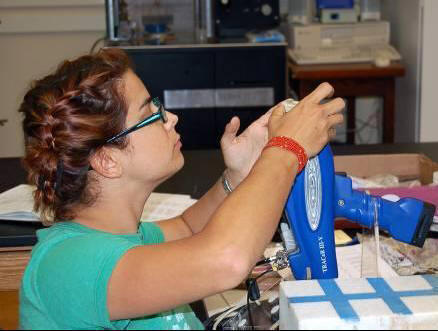 New
Project: Analysis of Surface Scale on Granite Headstones
New
Project: Analysis of Surface Scale on Granite Headstones
As part of her summer internship, graduate intern Caitlin O
’Grady studied scale that has been found on granite headstones in a variety of
cemeteries. Water samples from the areas were analyzed by ion chromatography and
chemical testing. Scale samples were analyzed by chemical spot testing, scanning
electron microscopy, optical microscopy, portable x-ray fluorescence
spectroscopy and other techniques. The project continues this year with
undergraduate intern, Ifrah Jamil.
Phase two of the Cemetery Cleaning Study Launched
NCPTT is moving forward with the second phase of a two-year
study to evaluate the effectiveness of commercial chemical cleaners for the
removal of biological growth and dirt from federally-issued headstones located
in national cemeteries across the nation. The work is performed in partnership
with the National Cemetery Administration, an office of the Department of
Veteran Affairs. During phase one of the project, headstones were tested for
biological growth and cleaned with five test chemicals at five climatically and
geographically distinct national cemeteries. Phase two begins the evaluation of
effectiveness by identifying biological re-growth on stones. Completion of this
study is expected in the summer of 2007. In relation to this project, summer
undergraduate intern, Georgette Lang, prepared a artificial weathering
experiment to compare the effects of various cleaners on marble. Results of this
project are currently being analyzed.
Durability of traditional and modified limewash for use at Cane
River Creole National Historical Park Completed
This project is a partnership between NCPTT, the Cane River
Creole National Historical Park (CARI), and Quality Finish, Inc. In the first
phase of this study a variety of modified limewashes were tested on weathered
wood, rough sawn wood, and brick. In the second phase, limewashes were applied
to additional handmade brick, weathered wood, and epoxy samples. Three
commercially available lime sources were also tested. Performance was evaluated
based on adhesion and abrasion tests as well as color change before and after
artificial weathering. Limewashes of lime and water without additives performed
best on brick samples. All limewashes performed poorly on weathered wood
samples. Mary Striegel and Sarah Jackson presented this research at The
Traditional Building Exhibition and Conference in Chicago, and at the . AIC
Annual Meeting in Providence. Final results
were presented at the Association for Preservation Technology Annual Conference
in Atlanta, by Sarah Jackson, and will be submitted for publication in the APT
Bulletin.
Evaluation of vitrification as a treatment for historic
terrazzo floors completed
The purpose of this study is to aid GSA in establishing a policy
for terrazzo care by providing scientific evidence to evaluate the vitrification
process. Tests were conducted that would directly address the GSA ’s specific
concerns about vitrification’s effects on terrazzo flooring: the chemical
changes on the surface, the ability of moisture to move through terrazzo, and
the suitability of the appearance.
NCPTT prepared sealed, waxed, and vitrified traditional terrazzo samples and
exposed them to a wide variety of chemical and physical tests. We investigated
surface changes, strength changes, liquid water and water vapor transport, and
appearance changes of the different surface treatments. Most recently, we
evaluated the potential of surface staining with a variety of stain sources
including wine and blood. We found that staining is a major
issue for vitrified terrazzo floors, while waxed floors offered the best
protection against most types of staining.
Final results of this work were presented at the Association for
Preservation Technology Annual Conference in Atlanta by Tye Botting, and will be
submitted for publication in the APT Bulletin.
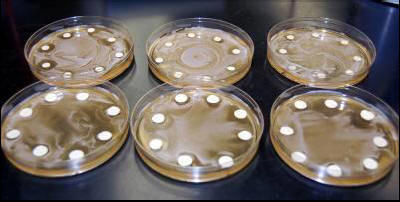 The
study of Alkoxygermane mixtures as biocides is completed
The
study of Alkoxygermane mixtures as biocides is completed
NCPTT undergraduate intern Cole Stevens completed his studies on
the alkoxgermanes added to commercially available stone consolidants this
summer. He worked closely with the NSU biology department to test the biocidal
properties of adding small amounts of ethyltriethoxygermane to the commercially
available stone consolidant, Prosoco OH100. He identified microorganisms
commonly found on stone grave markers from literature reviews and chose two
microorganisms, Thiobacillus sp. and Arthrobacter globiformis, for testing. He
acquired biological cultures of these organisms and tested the potential of
mixtures to kill and prevent biological growth. The initial evaluation of the
data shows that dilutions down to 100 mu g/ml
of ethyltriethoxygermane in Prosoco OH100 were capable of killing the
microorganisms. Dr. Gillian Rudd and student Ryan Metzger from the NSU chemistry
department are preparing the final report on this project.
Air pollution deposition studies on consolidated stone back on
track
The consolidant project has been plagued with numerous delays,
but now all chamber upgrades and repairs have been completed and the chamber has
just finished its first test run. During its downtime, extensive repairs and
replacements were put in place for almost all of its key parts. The computer
control system was upgraded as well. For this test run, eight Salem limestone
samples were run for 10 days to evaluate the chamber’s performance
and ensure comparable operation to previous work. Tye Botting, NCPTT’s joint
faculty appointment in the NSU Chemistry department continues this study.
Hurricane Recovery Efforts
Library of Congress Presentation
On March 2nd Mary Striegel served as an invited speaker for the
Library of Congress, Topics in Preservation Science Series. This hour-long
presentation, entitled “The Conservation Scientist versus Hurricane Katrina,”
highlighted Striegel’s experiences in the aftermath of Hurricane Katrina, during
which her preconceived notions of what the state of Louisiana needed were
replaced with more realistic approaches to collection salvage and stabilization.
The presentation provided an overview of FEMA processes, details of conditions
found, and efforts to save collections. The presentation was standing room only
with more than 75 professionals on-hand.
Heritage Emergency National Task Force holds Face-to-Face
Meeting
NCPTT was one of many organizations represented at a Heritage
Emergency National Task Force Meeting held March 3 at the National Archives in
Washington, D.C. Federal agencies and professional groups from around the
country met as part of ongoing efforts to understand the effects of Hurricanes
Katrina and Rita on cultural resources, to improve recovery efforts, and to plan
for future catastrophic events. The meeting included overview presentations from
state and local representatives, a FEMA briefing, and the development of
subcommittees targeting six major areas: (1) preparedness, (2) communications,
(3) resources, (4) On-site assistance, (5) financial assistance, and (6)
documentation. Each of the organizations represented were asked to contribute to
one of the areas if possible.
NCPTT-AIC Wet Recovery Workshops
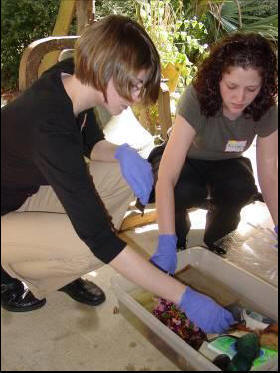 NCPTT
worked in conjunction with the American Institute for Conservation to produce
the workshop series, “After the Storm : Recovery of Wet Collections,” which w as
held in March. Instructors included Hilary Kaplan, Beverly Perkins, and Mary
Striegel. Workshops were held throughout
NCPTT
worked in conjunction with the American Institute for Conservation to produce
the workshop series, “After the Storm : Recovery of Wet Collections,” which w as
held in March. Instructors included Hilary Kaplan, Beverly Perkins, and Mary
Striegel. Workshops were held throughout
Louisiana:
-
March 16, National D-day Museum, New Orleans
-
March 17, LSU Rural Life Museum, Baton Rouge,
-
March 20, National Center for Preservation Technology and
Training, Natchitoches
The goal of these one-day workshops was to provide information
and public assistance to public and private non-profit organizations such as
libraries, universities and colleges, court houses, hospitals and others. The
focus of the workshops was the recovery of wet collections damaged by natural
disasters and preparation for possible future disasters.
In addition to the wet recovery workshops, the instructors
provided conservation advice to New Orleans organizations and individuals on
March 18. The team consulted with (1) the New Orleans Clerk of Court Evidence
Rooms, (2) the Backstreet Cultural Museum, (3) Dillard University Library and
(4) Dr. Michael White, jazz musician. A final report on this activity is
available.
Mary Striegel presents at AIC workshop on disaster assessment
and management
Based on her experiences with a FEMA detail after Hurricane
Katrina, Mary Striegel was asked to be an instructor in the AIC workshop, held
June 15. She spoke on the topics of architecture assessments and presented the
Rapid Building and Site Condition Assessment Forms developed in conjunction with
the National Heritage Emergency Task Force. In addition, she spoke about how
assessment data was being used after Hurricane Katrina.
 Piggybacking
on to the AIC annual meeting, Mary Striegel and Paul Messier were part of a
half-day symposium on cultural resources and disasters held June 14 as part of
the AIC angels project hosted at the Newport Historical Society. The symposium
covered a range of topics from the effects of fires, floods, and hurricanes on
cultural collecting institutions to first steps in recovery.
Piggybacking
on to the AIC annual meeting, Mary Striegel and Paul Messier were part of a
half-day symposium on cultural resources and disasters held June 14 as part of
the AIC angels project hosted at the Newport Historical Society. The symposium
covered a range of topics from the effects of fires, floods, and hurricanes on
cultural collecting institutions to first steps in recovery.
Consultation about Hurricane Damaged Cemeteries
In August, NCPTT provided a day-long consultation with Sipapu
Cemetery Services. Sipapu served with DMORT, the Disaster Mortuary Team, and
with the Louisiana Family Assistance program for the state. They sought advice
and technical assistance regarding damage to 82 cemeteries along the Louisiana
gulf coast region. Damage included the erosion of over 1550 graves in cemeteries
within the hurricane affected areas. To date, only three
cemeteries qualify for FEMA public assistance. NCPTT is looking into various
options for technical assistance including the development of a specialized
disaster recovery workshop for these cemeteries.
Training
National cemetery preservation initiative
Through this initiative, NCPTT has developed a full suite of
training for a wide range of audiences. The Cemetery Monument Conservation
Basics Workshop is a public-friendly program designed to introduce basic tools
to conserve headstones. The fourth Cemetery Monument Conservation Workshop is
the professionally-oriented staple of this initiative that teaches a full range
of preservation subjects. The new Advanced Cemetery Monument Conservation
Workshops completes the trio and guides participants who have previously
participated in one of our workshop through the preservation of complex grave
marker issues. NCPTT strives to develop new audiences for cemetery preservation
through partnerships with allied professional organizations such as the Monument
Builders of North America.
 NCPTT
teams with NPS Historic Preservation Training Center for a Successful Advanced
Cemetery Workshop
NCPTT
teams with NPS Historic Preservation Training Center for a Successful Advanced
Cemetery Workshop
NCPTT’s new Advanced Cemetery Monument Conservation workshop was
held as part of the NCPTT Summer Institute from July 10-14, 2006 in
Natchitoches, Louisiana. NPS Historic Preservation Training Center (HPTC) in
Fredericksburg, Md., provided two instructors, Rene Laya and Dominic DeRubis,
who specialized in masonry, historic stuccos and lime mortars. Cathedral Stone,
Inc. provided day-long training on the use of Jahn patching and repair
materials. The successful workshop provided extensive field learning to six
participants on the topics of stone monument cleaning, adhesive repair, color
matched fills, historic lime stucco, lime mortar brick masonry and lime wash.
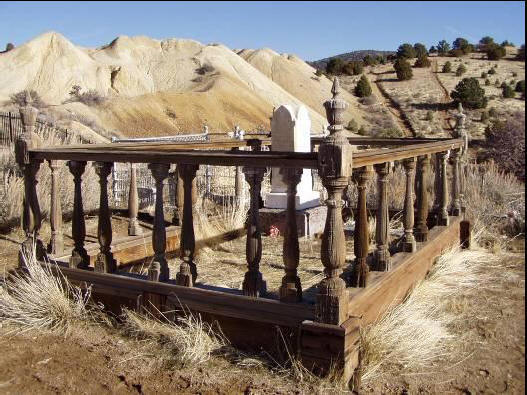 2006
Cemetery Monument Conservation Workshop held in Virginia City
2006
Cemetery Monument Conservation Workshop held in Virginia City
NCPTT partnered with the Comstock Cemetery Foundation, Pacific
West Regional office of the National Park Service, and the SHPO of Nevada to
present the Southwest Regional Cemetery Monument Conservation Workshop on
September 26-28 in Virginia City, Nev.. This three-day workshop focused on
hands-on conservation treatments crucial to the preservation of historic grave
markers. This workshop had a special focus on wood conservation. Additional
topics included condition assessment, adhesion and reinforced repair, cleaning,
protection, stone repairs, bases and resetting, and safe handling techniques.
Instructors for the workshop included Terry Amburgey, Jason Church, Fran Gale,
Dennis Montagna, Karl Munson, Shelley Sass, Irving Slavid, Mary Striegel, and
Norman Weiss. Eighteen participants registered for the event.
Meetings, Presentations
Northwestern State University Research Day highlights NCPTT
research
Undergraduate intern Cole Stevens presented the results of his
NCPTT work on developing new alternative stone strengtheners with potential
biocidal properties. The work draws on three years of basic research into the
synthesis, polymerization, and application of germanium-based compounds. Cole
was one of five students nominated for the Mildred Hart Bailey undergraduate
research award. His work is supervised by Mary F. Striegel and Tye Botting.
Jason Church attended Metals Conservation Workshop
Jason Church, was selected to attend the 2006 Metals
Conservation Summer Institute sponsored by the Higgins Armory Museum and the
Metal Processing Institute at Worchester Polytechnic Institute. The institute,
held May 27 - June 7, in Worchester, Mass. provided participants with hands-on,
lab-based opportunities to investigate the fields of metallurgy and conservation
from a new perspective, using the combined facilities, faculties and collections
of nationally recognized museums and universities.
Tye Botting represents NCPTT at the “Recent Research and
Technical Innovations in Brownstone Conservation Symposium ”
Tye Botting monitored the 2005 PTT Grant funded symposium on the
conservation of Brownstone held May 13, in Portland, Maine and organized by the
Victoria Mansion. This symposium brought together six speakers on the topic.
More than 80 participants learned more about the physical properties,
fabrication, consolidation, and treatments related to brownstone.
NCPTT at the African-American Preservation Alliance Conference
Jason Church and summer intern Ervin James, along with Rolonda
Teal of the Cane River Heritage Area (CARI) presented at the African-American
Preservation Alliance (AAPA) Conference, held Aug. 3-5 in Memphis,. T he
presentation entitled “The Importance of the Cemetery in Northwest Louisiana’s
African -American Community” focused on research done by NCPTT and CARI. This
research included oral histories of traditional funerary and burial practices as
well as cemetery documentation.
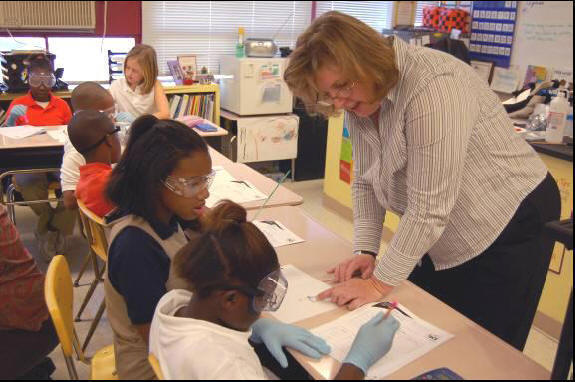 Heritage
Education and Materials Research team up for Science and Art lectures
Heritage
Education and Materials Research team up for Science and Art lectures
Mary Striegel, Jason Church, and Chris Faith were invited by
the fifth grade classes of the new Natchitoches Magnet school to present a
chemistry-based activity on Science and Art. Striegel lectured on ways that
science and chemistry can be used to preserve art for future generations. The
lecture was followed by hands on activities. The students were taught the
principles of thin layer chromatography and its usefulness in identifying art
media binders. In the experiment the fifth graders separated an ink sample into
its component chemicals.